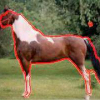Free Online Productivity Tools
i2Speak
i2Symbol
i2OCR
iTex2Img
iWeb2Print
iWeb2Shot
i2Type
iPdf2Split
iPdf2Merge
i2Bopomofo
i2Arabic
i2Style
i2Image
i2PDF
iLatex2Rtf
Sci2ools
105
Voted
CVPR
2008
IEEE
2008
IEEE
The Logistic Random Field - A convenient graphical model for learning parameters for MRF-based labeling
Graphical models are fundamental tools for modeling images and other applications. In this paper, we propose the Logistic Random Field (LRF) model for representing a discrete-valued graphical model. The LRF model is based on an underlying quadratic model and a logistic function. The chief advantages of the LRF are its convenience and flexibility. The quadratic model makes inference easy to implement using standard numerical linear algebra routines. This quadratic model also allows the log-likelihood of the training data to be differentiated with respect to any parameter in the model, enhancing the flexibility of the LRF model. To demonstrate the usefulness of this model we use it to learn how to segment objects, specifically roads, horses, and cows. In addition, we demonstrate the flexibility of the LRF model by incorporating super-pixels. We then show that the LRF segmentation model produces segmentations that are competitive with recently published results.
Computer Vision | CVPR 2008 | Discrete-valued Graphical Model | Lrf Model | Lrf Segmentation Model | Model Makes Inference | Quadratic Model |
Related Content
| Added | 12 Oct 2009 |
| Updated | 28 Oct 2009 |
| Type | Conference |
| Year | 2008 |
| Where | CVPR |
| Authors | Marshall F. Tappen, Kegan G. G. Samuel, Craig V. Dean, David M. Lyle |
Comments (0)

